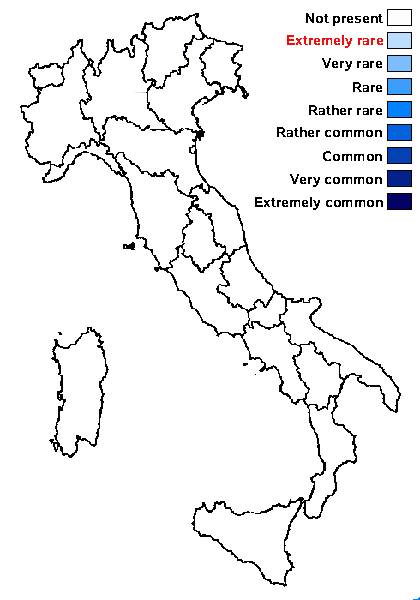Fellhanera ochracea Sparrius & Aptroot
Lichenologist, 32: 516, 2000
Synonyms:
Distribution:
Description: Thallus crustose, episubstratic, thin and smooth to thick and scurfy, ecorticate, staining the bark grey-green, often with a yellowish tinge, esorediate, forming up to 4 cm wide patches which often coalesce to cover larger areas. Apothecia biatorine, usually rare, 0.1-0.2 mm across, with an ochraceous to pale brown, convex disc often appearing slightly pruinose in marginal parts due to extruding hyphae, and a concolorous to paler, very thin, finally inapparent proper margin. Proper exciple poorly developed, with small orange crystals, up to 50 µm wide, of slender-celled hyphae resembling paraphyses; epithecium brownish, with orange crystals, 10-25 µm high; hymenium colourless, 40-60 µm high, I+ blue; paraphyses sparse, slender, branched and anastomosing, up to 1 µm thick; hypothecium reddish- to orange-brown, 40-80 µm high. Asci 8-spored, clavate, with a K/I+ blue apical dome containing a darker blue, tubular ring-structure, and an amyloid coat, Byssoloma-type, filled with orange crystals when overmature. Ascospores 3-septate, hyaline, clavate, often slightly curved, the upper two cells larger than others, 10-17 x 3-3.5(-4) µm, thin walled. Pycnidia always abundant, conspicuous, sessile, often of two colours: bluish grey and yellowish brown, globose when young, cup-shaped when old, epruinose, 0.05-0.2 mm across, the wall with orange crystals which are soluble in K, insoluble in acetone and HCI, N+ red. Conidia pyriform to tear-shaped, 4-6 x 1-1.7(-2) µm. Photobiont chlorococcoid, the cells 5-12 µm wide. Spot tests: thallus K-, C-, KC-, P-, UV-. Chemistry: thallus without lichen substances. Note: a recently-described, apparently rapidly spreading species found on the bark of conifers (e.g. Pseudotsuga, Pinus) and deciduous broadleaved trees with base-rich bark (e.g. Acer, Fraxinus, Salix, Ulmus), mostly near the base of trunks and in sheltered situations, often also in urban environments. Known from several Central European countries but easily overlooked, being often sterile; to be looked for in Italy.
Growth form: Crustose
Substrata: bark
Photobiont: green algae other than Trentepohlia
Reproductive strategy: mainly sexual
Most common in areas with a humid-warm climate (e.g. most of Tyrrenian Italy)

Predictive model
Growth form: Crustose
Substrata: bark
Photobiont: green algae other than Trentepohlia
Reproductive strategy: mainly sexual
Most common in areas with a humid-warm climate (e.g. most of Tyrrenian Italy)

Predictive model
 Index Fungorum
Index Fungorum
 GBIF
GBIF

